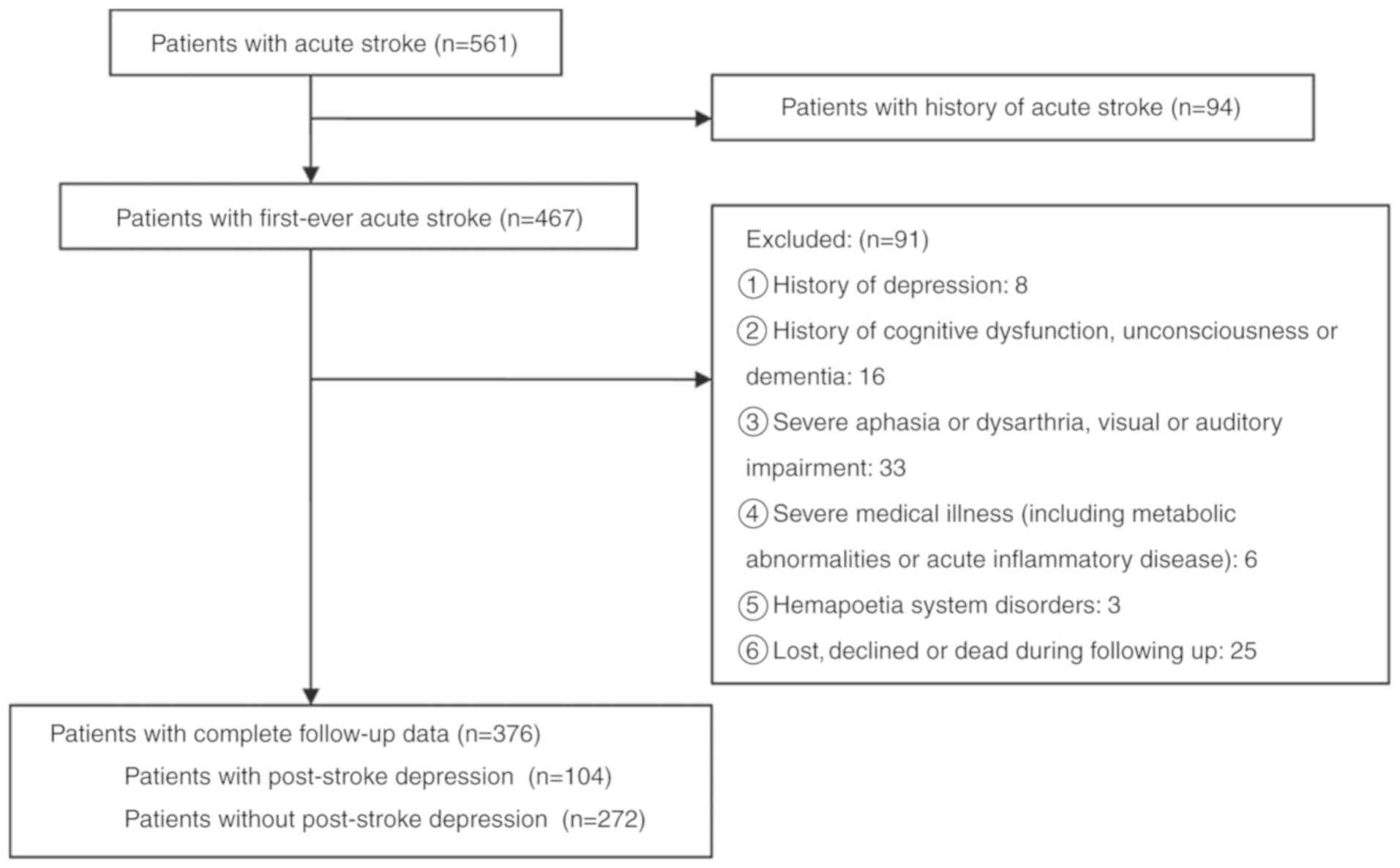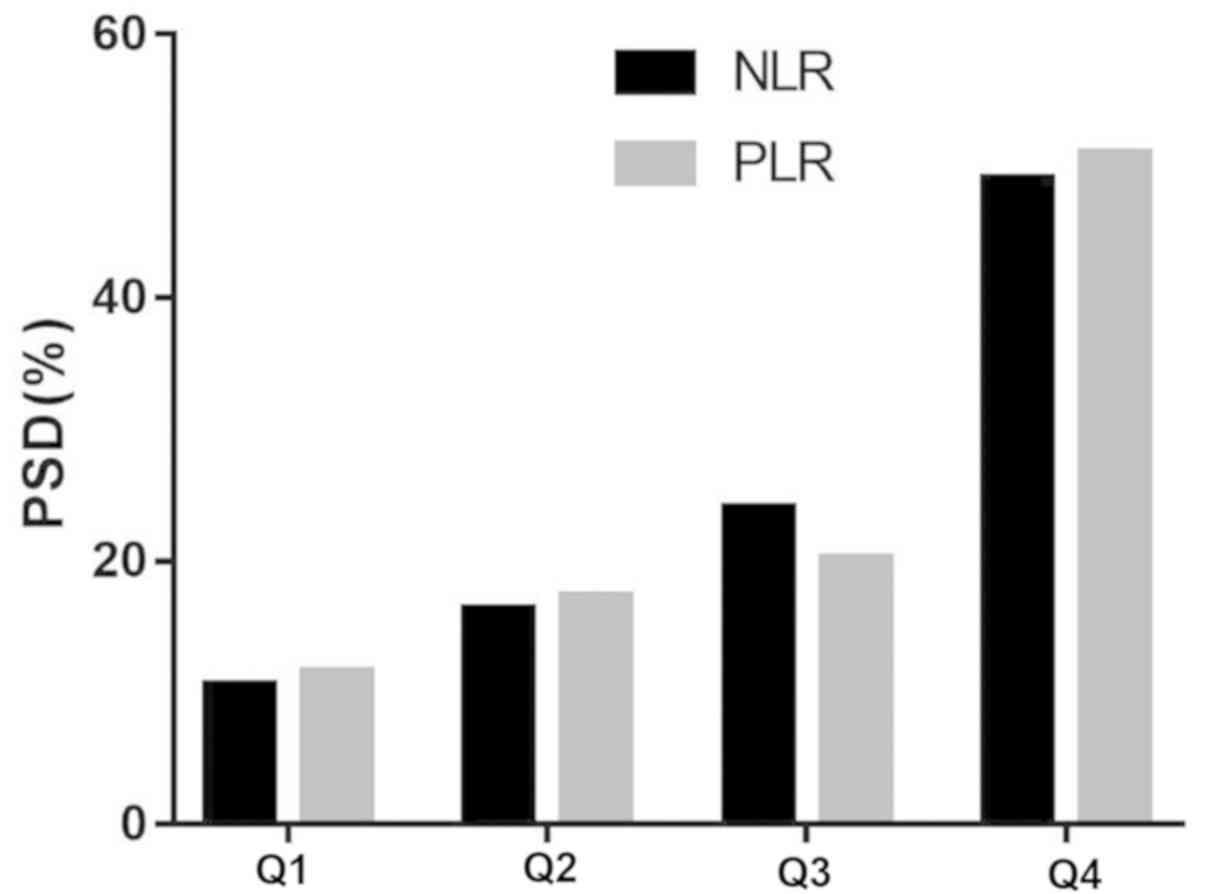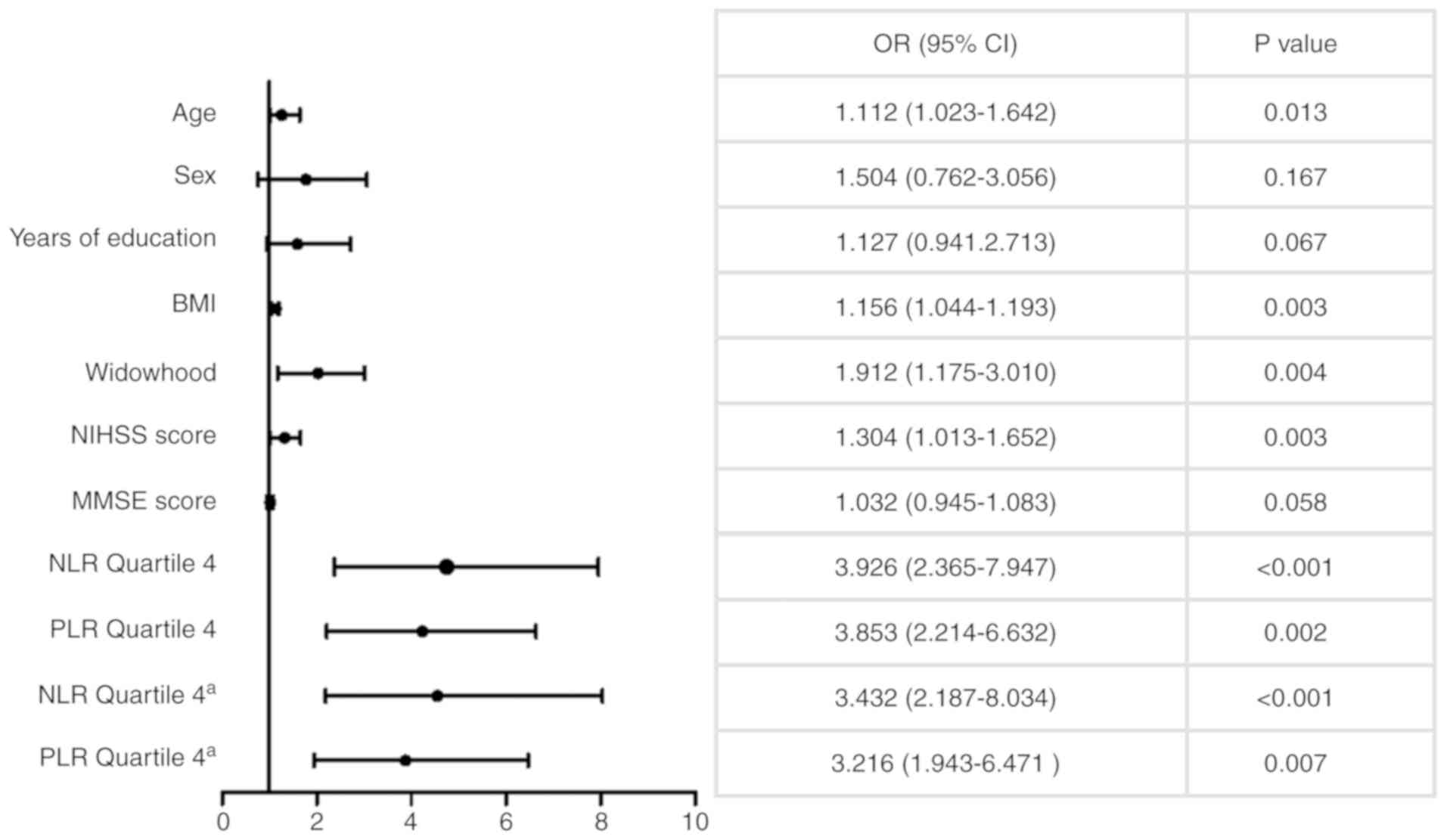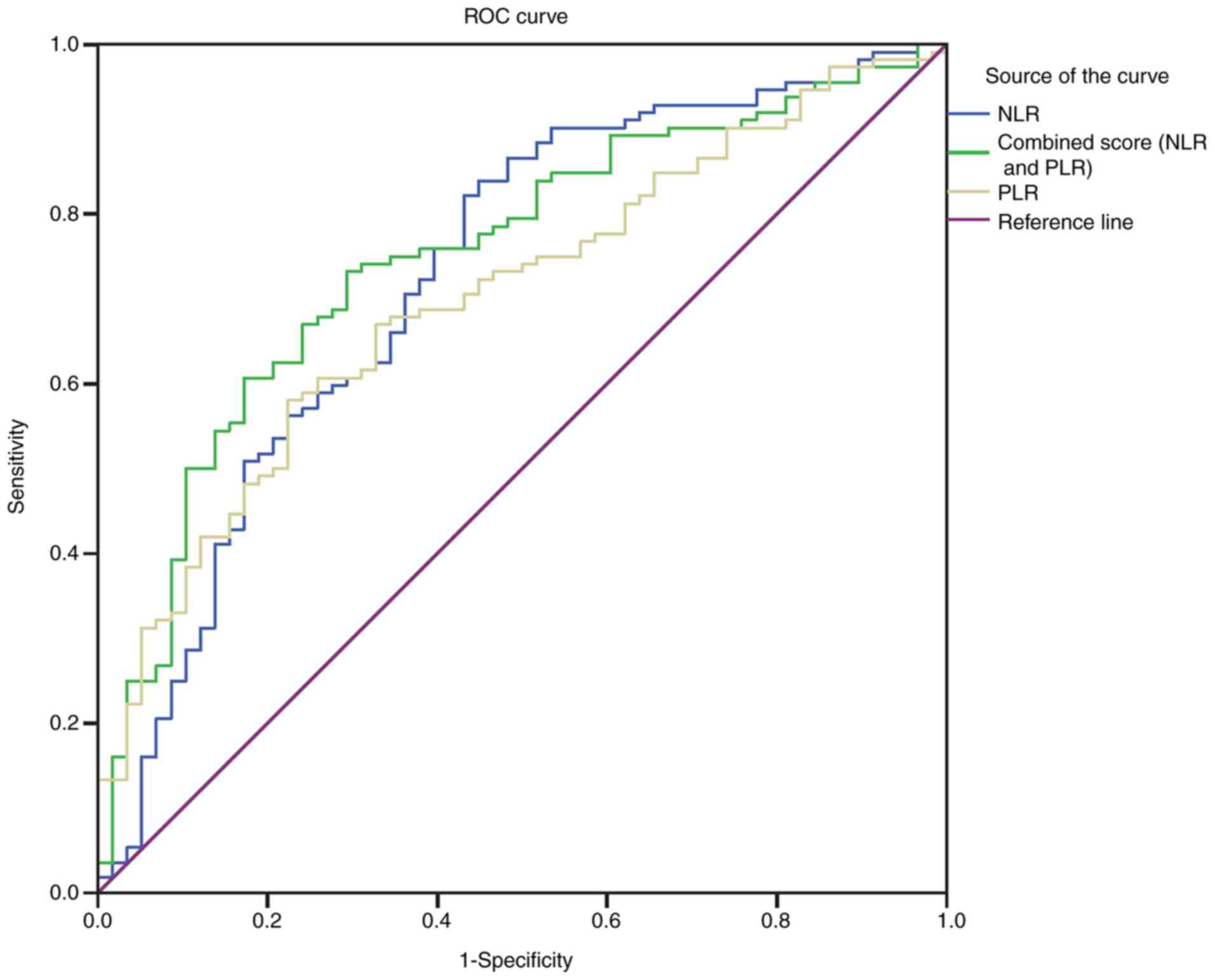|
1
|
Towfighi A, Ovbiagele B, El Husseini N,
Hackett ML, Jorge RE, Kissela BM, Mitchell PH, Skolarus LE, Whooley
MA and Williams LS: American Heart Association Stroke Council;
Council on Cardiovascular and Stroke Nursing; and Council on
Quality of Care and Outcomes Research: Poststroke depression: A
scientific statement for healthcare professionals from the American
heart association/American stroke association. Stroke.
48(e30-e43)2017.PubMed/NCBI View Article : Google Scholar
|
|
2
|
Guajardo VD, Terroni L, Sobreiro Mde F,
Zerbini MI, Tinone G, Scaff M, Iosifescu DV, de Lucia MC and
Fráguas R: The influence of depressive symptoms on quality of life
after stroke: A prospective study. J Stroke Cerebrovasc Dis.
24:201–209. 2015.PubMed/NCBI View Article : Google Scholar
|
|
3
|
Ferrari F and Villa RF: The neurobiology
of depression: An integrated overview from biological theories to
clinical evidence. Mol Neurobiol. 54:4847–4865. 2017.PubMed/NCBI View Article : Google Scholar
|
|
4
|
Becker KJ: Inflammation and the silent
sequelae of stroke. Neurotherapeutics. 13:801–810. 2016.PubMed/NCBI View Article : Google Scholar
|
|
5
|
Zeng L, Wang Y, Liu J, Wang L, Weng S,
Chen K, Domino EF and Yang GY: Pro-inflammatory cytokine network in
peripheral inflammation response to cerebral ischemia. Neurosci
Lett. 548:4–9. 2013.PubMed/NCBI View Article : Google Scholar
|
|
6
|
Waisman A, Hauptmann J and Regen T: The
role of IL-17 in CNS diseases. Acta Neuropathol. 129:625–637.
2015.PubMed/NCBI View Article : Google Scholar
|
|
7
|
Bodhankar S, Chen Y, Vandenbark AA, Murphy
SJ and Offner H: Treatment of experimental stroke with
IL-10-producing B-cells reduces infarct size and peripheral and CNS
inflammation in wild-type B-cell-sufficient mice. Metab Brain Dis.
29:59–73. 2014.PubMed/NCBI View Article : Google Scholar
|
|
8
|
Patel A: Review: The role of inflammation
in depression. Psychiatr Danub. 25 (Suppl
2)(S216-S223)2013.PubMed/NCBI
|
|
9
|
Hannestad J, DellaGioia N and Bloch M: The
effect of antidepressant medication treatment on serum levels of
inflammatory cytokines: A meta-analysis. Neuropsychopharmacology.
36:2452–2459. 2011.PubMed/NCBI View Article : Google Scholar
|
|
10
|
Maes M: Depression is an inflammatory
disease, but cell-mediated immune activation is the key component
of depression. Prog Neuropsychopharmacol Biol Psychiatry.
35:664–675. 2011.PubMed/NCBI View Article : Google Scholar
|
|
11
|
Su JA, Chou SY, Tsai CS and Hung TH:
Cytokine changes in the pathophysiology of poststroke depression.
Gen Hosp Psychiatry. 34:35–39. 2012.PubMed/NCBI View Article : Google Scholar
|
|
12
|
Yin J, Zhong C, Zhu Z, Bu X, Xu T, Guo L,
Wang X, Zhang J, Cui Y, Li D, et al: Elevated circulating
homocysteine and high-sensitivity C-reactive protein jointly
predicts post-stroke depression among Chinese patients with acute
ischemic stroke. Clin Chim Acta. 479:132–137. 2018.PubMed/NCBI View Article : Google Scholar
|
|
13
|
Arbel Y, Finkelstein A, Halkin A, Birati
EY, Revivo M, Zuzut M, Shevach A, Berliner S, Herz I, Keren G and
Banai S: Neutrophil/lymphocyte ratio is related to the severity of
coronary artery disease and clinical outcome in patients undergoing
angiography. Atherosclerosis. 225:456–460. 2012.PubMed/NCBI View Article : Google Scholar
|
|
14
|
Kasama T, Miwa Y, Isozaki T, Odai T,
Adachi M and Kunkel SL: Neutrophil-derived cytokines: Potential
therapeutic targets in inflammation. Curr Drug Targets Inflamm
Allergy. 4:273–279. 2005.PubMed/NCBI View Article : Google Scholar
|
|
15
|
Nam KW, Kwon HM, Jeong HY, Park JH, Kim SH
and Jeong SM: High neutrophil to lymphocyte ratios predict
intracranial atherosclerosis in a healthy population.
Atherosclerosis. 269:117–121. 2018.PubMed/NCBI View Article : Google Scholar
|
|
16
|
Goyal N, Tsivgoulis G, Chang JJ, Malhotra
K, Pandhi A, Ishfaq MF, Alsbrook D, Arthur AS, Elijovich L and
Alexandrov AV: Admission neutrophil-to-lymphocyte ratio as a
prognostic biomarker of outcomes in large vessel occlusion strokes.
Stroke. 49:1985–1987. 2018.PubMed/NCBI View Article : Google Scholar
|
|
17
|
Tekesin A and Tunç A: Inflammatory markers
are beneficial in the early stages of cerebral venous thrombosis.
Arq Neuropsiquiatr. 77:101–105. 2019.PubMed/NCBI View Article : Google Scholar
|
|
18
|
Demircan F, Gözel N, Kılınç F, Ulu R and
Atmaca M: The impact of red blood cell distribution width and
neutrophil/lymphocyte ratio on the diagnosis of major depressive
disorder. Neurol Ther. 5:27–33. 2016.PubMed/NCBI View Article : Google Scholar
|
|
19
|
Cai L, Xu L, Wei L and Chen W:
Relationship of mean platelet volume To MDD: A retrospective study.
Shanghai Arch Psychiatry. 29:21–29. 2017.PubMed/NCBI View Article : Google Scholar
|
|
20
|
Huang G, Chen H, Wang Q, Hong X, Hu P,
Xiao M, Shu M and He J: High platelet-to-lymphocyte ratio are
associated with post-stroke depression. J Affect Disord.
246:105–111. 2019.PubMed/NCBI View Article : Google Scholar
|
|
21
|
Chen H, Luan X, Zhao K, Qiu H, Liu Y, Tu
X, Tang W and He J: The association between
neutrophil-to-lymphocyte ratio and post-stroke depression. Clin
Chim Acta. 486:298–302. 2018.PubMed/NCBI View Article : Google Scholar
|
|
22
|
Huang H, Zheng T, Wang S, Wei L, Wang Q
and Sun Z: Serum 25-hydroxyvitamin D predicts early recurrent
stroke in ischemic stroke patients. Nutr Metab Cardiovasc Dis.
26:908–914. 2016.PubMed/NCBI View Article : Google Scholar
|
|
23
|
First MB and Gibbon M: The structured
clinical interview for DSM-IV Axis I disorders (SCID-I) and the
structured clinical interview for DSM-IV Axis II disorders
(SCID-II) In: Comprehensive Handbook of Psychological Assessment,
Vol. 2. Personality assessment. Hilsenroth MJ and Segal DL (eds.).
John Wiley & Sons Inc., Hoboken NJ, 134-143, 2004.
|
|
24
|
Hamilton M: A rating scale for depression.
J Neurol Neurosurg Psychiatry. 23:56–62. 1960.PubMed/NCBI View Article : Google Scholar
|
|
25
|
Brott T, Adams HP Jr, Olinger CP, Marler
JR, Barsan WG, Biller J, Spilker J, Holleran R, Eberle R and
Hertzberg V: Measurements of acute cerebral infarction: A clinical
examination scale. Stroke. 20:864–870. 1989.PubMed/NCBI View Article : Google Scholar
|
|
26
|
Folstein MF, Folstein SE and McHugh PR:
‘Mini-mental state’. A practical method for grading the cognitive
state of patients for the clinician. J Psychiatr Res. 12:189–198.
1975.PubMed/NCBI View Article : Google Scholar
|
|
27
|
Qun S, Tang Y, Sun J, Liu Z, Wu J, Zhang
J, Guo J, Xu Z, Zhang D, Chen Z, et al: Neutrophil-to-lymphocyte
ratio predicts 3-month outcome of acute ischemic stroke. Neurotox
Res. 31:444–452. 2017.PubMed/NCBI View Article : Google Scholar
|
|
28
|
Buyukkaya E, Karakas MF, Karakas E, Akcay
AB, Tanboga IH, Kurt M and Sen N: Correlation of neutrophil to
lymphocyte ratio with the presence and severity of metabolic
syndrome. Clin Appl Thromb Hemost. 20:159–163. 2014.PubMed/NCBI View Article : Google Scholar
|
|
29
|
Balta S, Celik T, Mikhailidis DP, Ozturk
C, Demirkol S, Aparci M and Iyisoy A: The relation between
atherosclerosis and the neutrophil-lymphocyte ratio. Clin Appl
Thromb Hemost. 22:405–411. 2016.PubMed/NCBI View Article : Google Scholar
|
|
30
|
Zhang RL, Chopp M, Chen H and Garcia JH:
Temporal profile of ischemic tissue damage, neutrophil response,
and vascular plugging following permanent and transient (2H) middle
cerebral artery occlusion in the rat. J Neurol Sci. 125:3–10.
1994.PubMed/NCBI View Article : Google Scholar
|
|
31
|
Ciree A, Michel L, Camilleri-Broet S, Jean
Louis F, Oster M, Flageul B, Senet P, Fossiez F, Fridman WH,
Bachelez H and Tartour E: Expression and activity of IL-17 in
cutaneous T-cell lymphomas (mycosis fungoides and Sezary syndrome).
Int J Cancer. 112:113–120. 2004.PubMed/NCBI View Article : Google Scholar
|
|
32
|
Celikbilek A, Ismailogullari S and
Zararsiz G: Neutrophil to lymphocyte ratio predicts poor prognosis
in ischemic cerebrovascular disease. J Clin Lab Anal. 28:27–31.
2014.PubMed/NCBI View Article : Google Scholar
|
|
33
|
Gibson PH, Cuthbertson BH, Croal BL, Rae
D, El-Shafei H, Gibson G, Jeffrey RR, Buchan KG and Hillis GS:
Usefulness of neutrophil/lymphocyte ratio as predictor of new-onset
atrial fibrillation after coronary artery bypass grafting. Am J
Cardiol. 105:186–191. 2010.PubMed/NCBI View Article : Google Scholar
|
|
34
|
Furtado M and Katzman MA: Examining the
role of neuroinflammation in major depression. Psychiatry Res.
229:27–36. 2015.PubMed/NCBI View Article : Google Scholar
|
|
35
|
Li W, Ling S, Yang Y, Hu Z, Davies H and
Fang M: Systematic hypothesis for post-stroke depression caused
inflammation and neurotransmission and resultant on possible
treatments. Neuro Endocrinol Lett. 35:104–109. 2014.PubMed/NCBI
|
|
36
|
Afari ME and Bhat T: Neutrophil to
lymphocyte ratio (NLR) and cardiovascular diseases: An update.
Expert Rev Cardiovasc Ther. 14:573–577. 2016.PubMed/NCBI View Article : Google Scholar
|
|
37
|
Li H, Zhou Y, Ma Y, Han S and Zhou L: The
prognostic value of the platelet-to-lymphocyte ratio in acute
coronary syndrome: A systematic review and meta-analysis. Kardiol
Pol. 75:666–673. 2017.PubMed/NCBI View Article : Google Scholar
|
|
38
|
Li DY, Hao XY, Ma TM, Dai HX and Song YS:
The prognostic value of platelet-to-lymphocyte ratio in urological
cancers: A meta-analysis. Sci Rep. 7(15387)2017.PubMed/NCBI View Article : Google Scholar
|
|
39
|
Chandrashekara S, Mukhtar Ahmad M, Renuka
P, Anupama KR and Renuka K: Characterization of
neutrophil-to-lymphocyte ratio as a measure of inflammation in
rheumatoid arthritis. Int J Rheum Dis. 20:1457–1467.
2017.PubMed/NCBI View Article : Google Scholar
|
|
40
|
Demir S, Atli A, Bulut M, İbiloğlu AO,
Güneş M, Kaya MC, Demirpençe Ö and Sır A: Neutrophil-lymphocyte
ratio in patients with major depressive disorder undergoing no
pharmacological therapy. Neuropsychiatr Dis Treat. 11:2253–2258.
2015.PubMed/NCBI View Article : Google Scholar
|
|
41
|
Ivković M, Pantović-Stefanović M,
Dunjić-Kostić B, Jurišić V, Lačković M, Totić-Poznanović S,
Jovanović AA and Damjanović A: Neutrophil-to-lymphocyte ratio
predicting suicide risk in euthymic patients with bipolar disorder:
Moderatory effect of family history. Compr Psychiatry. 66:87–95.
2016.PubMed/NCBI View Article : Google Scholar
|
|
42
|
Mayda H, Ahsen A, Bağcioğlu E, Öztürk A,
Bahçeci B, Soyuçok E, Başpinar E and Ulu MS: Effect of increased
neutrophil-to-lymphocyte ratio (NLR) and decreased mean platelet
volume (MPV) values on inflammation in acute mania. Noro Psikiyatr
Ars. 53:317–320. 2016.PubMed/NCBI View Article : Google Scholar
|
|
43
|
Morel-Kopp MC, McLean L, Chen Q, Tofler
GH, Tennant C, Maddison V and Ward CM: The association of
depression with platelet activation: Evidence for a treatment
effect. J Thromb Haemost. 7:573–581. 2009.PubMed/NCBI View Article : Google Scholar
|
|
44
|
Ormonde do Carmo MB, Mendes-Ribeiro AC,
Matsuura C, Pinto VL, Mury WV, Pinto NO, Moss MB, Ferraz MR and
Brunini TM: Major depression induces oxidative stress and platelet
hyperaggregability. J Psychiatric Res. 61:19–24. 2015.PubMed/NCBI View Article : Google Scholar
|
|
45
|
Gokdemir MT, Karakilcik AZ and Gokdemir
GS: Prognostic importance of paraoxonase, arylesterase and mean
platelet volume efficiency in acute ischaemic stroke. J Pak Med
Assoc. 67:1679–1683. 2017.PubMed/NCBI
|
|
46
|
Dietrich-Muszalska A and Wachowicz B:
Platelet haemostatic function in psychiatric disorders: Effects of
antidepressants and antipsychotic drugs. World J Biol Psychiatry.
18:564–574. 2017.PubMed/NCBI View Article : Google Scholar
|
|
47
|
Zafar MU, Paz-Yepes M, Shimbo D, Vilahur
G, Burg MM, Chaplin W, Fuster V, Davidson KW and Badimon JJ:
Anxiety is a better predictor of platelet reactivity in coronary
artery disease patients than depression. Eur Heart J. 31:1573–1582.
2010.PubMed/NCBI View Article : Google Scholar
|
|
48
|
Mazza MG, Lucchi S, Tringali AGM, Rossetti
A, Botti ER and Clerici M: Neutrophil/lymphocyte ratio and
platelet/lymphocyte ratio in mood disorders: A meta-analysis. Prog
Neuropsychopharmacol Boil Psychiatry. 84:229–236. 2018.PubMed/NCBI View Article : Google Scholar
|
|
49
|
McCorvy JD, Wacker D, Wang S, Agegnehu B,
Liu J, Lansu K, Tribo AR, Olsen RHJ, Che T, Jin J and Roth BL:
Structural determinants of 5-HT2B receptor activation and biased
agonism. Nat Struct Mol Biol. 25:787–796. 2018.PubMed/NCBI View Article : Google Scholar
|
|
50
|
Liu CS, Adibfar A, Herrmann N, Gallagher D
and Lanctot KL: Evidence for inflammation-associated depression.
Curr Top Behav Neurosci. 31:3–30. 2017.PubMed/NCBI View Article : Google Scholar
|
|
51
|
Kayhan F, Gündüz Ş, Ersoy SA, Kandeğer A
and Annagür BB: Relationships of neutrophil-lymphocyte and
platelet-lymphocyte ratios with the severity of major depression.
Psychiatry Res. 247:332–335. 2017.PubMed/NCBI View Article : Google Scholar
|
|
52
|
Esenwa CC and Elkind MS: Inflammatory risk
factors, biomarkers and associated therapy in ischaemic stroke. Nat
Rev Neurol. 12:594–604. 2016.PubMed/NCBI View Article : Google Scholar
|
|
53
|
Nemeroff CB and Musselman DL: Are
platelets the link between depression and ischemic heart disease?
Am Heart J. 140 (4 Suppl)(S57-S62)2000.PubMed/NCBI View Article : Google Scholar
|
|
54
|
Musselman DL, Tomer A, Manatunga AK,
Knight BT, Porter MR, Kasey S, Marzec U, Harker LA and Nemeroff CB:
Exaggerated platelet reactivity in major depression. Am J
Psychiatry. 153:1313–1317. 1996.PubMed/NCBI View Article : Google Scholar
|
|
55
|
Altintas O, Altintas MO, Tasal A,
Kucukdagli OT and Asil T: The relationship of
platelet-to-lymphocyte ratio with clinical outcome and final
infarct core in acute ischemic stroke patients who have undergone
endovascular therapy. Neurol Res. 38:759–765. 2016.PubMed/NCBI View Article : Google Scholar
|


















